CANADIAN & VINTAGE LIGHTWEIGHT BICYCLE
LEATHER SADDLES - CARE AND FEEDING
e-mail [email protected]
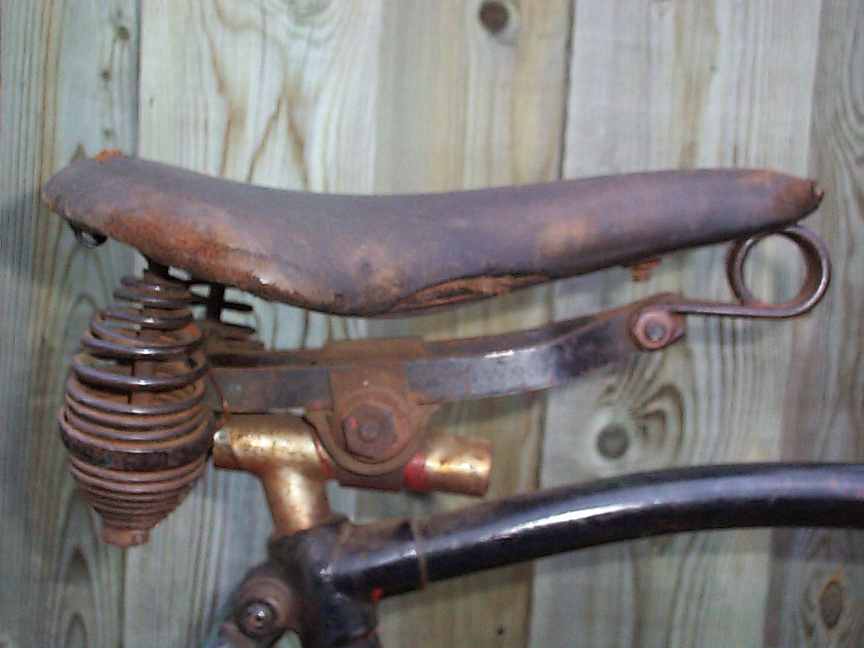
ARE THEY FOR YOU?
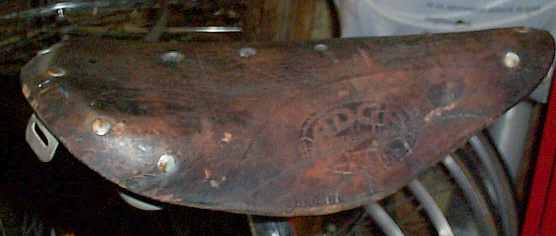
MADE IN FRANCE
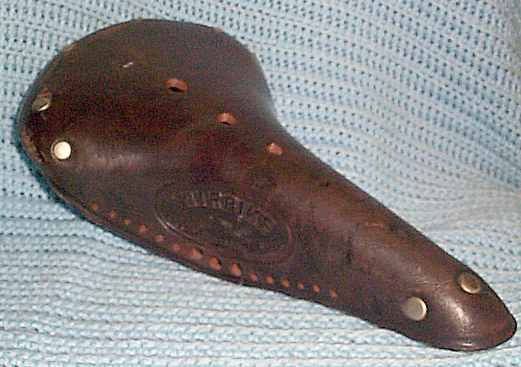
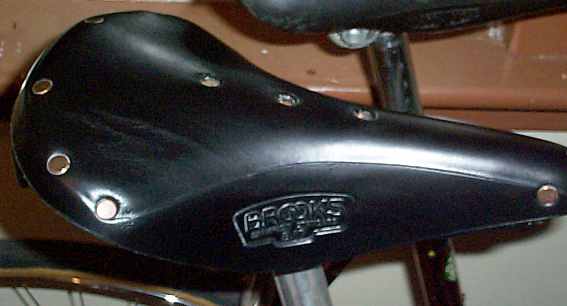

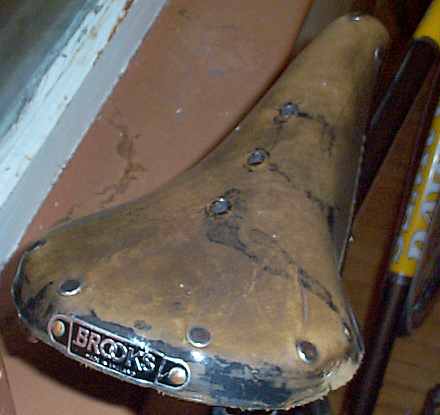
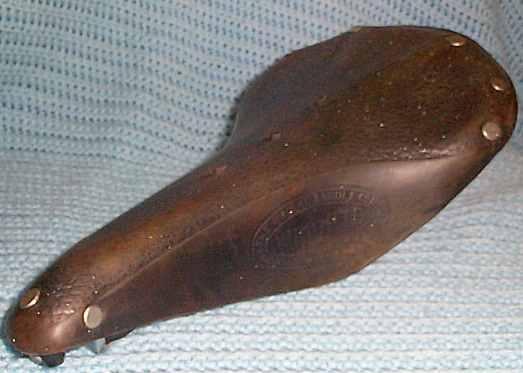
As mentioned, leather bicycle saddles have been around just about as long as dirt has. This summer past, a local bicycle shop elected to order in three Brooks leather saddles, one B17 Special in a gorgeous honey color and two B17 regular saddles, both dyed black.
Initial inspection, prompted more out of curiosity rather than intent to purchase, revealed a saddle surface that is just about as hard as a door. In fact, one can actually knock on the saddle�s surface and get the same sound that causes most of us to jump up and see who�s there. How could something this hard and antiquated be comfortable? Part of this web site�s purpose is to help me and others understand the virtues and vices of vintage lightweight bicycle ownership. With this in mind, the Brooks B17 Special was purchased, for $145.00 Canadian, and promptly installed on a 1984 (Made in Canada) Peugeot �Super Sport�.
Since I began collecting vintage lightweight bicycles, nine or ten months ago, I have acquired several old leather saddles, some of which are in quite good condition. In the time mentioned, two Wright�s leather saddles have entered a collection which now includes: the two new Brooks saddles I use on a regular basis, one vintage Brooks that graces an all but pristine Dawes �Galaxy�, a French made AGDA saddle sitting atop a Made in France Peugeot UO8, two Air Bike seats plucked from aging CCM bicycles and a mystery saddle, with no identifying markings that presently resides on my Holdsworth �Equipe�.
The first Wright�s saddle showed up one morning, attached to a woman�s ten speed. The bicycle had been left leaning against my shed door and it took several days to find out where it had come from. As it turned out, one of my neighbors gave the ten speed, Wrights saddle and all, to me in an effort to get the old and unwanted bicycle out of his basement. The saddle was covered with, what appeared to be, latex paint splatters, most of which have been painstakingly removed. The saddle itself was in very good condition, otherwise, requiring �Proof Hiding� to restore the leather�s flexibility. It has not been installed on a bicycle but it is likely that it will soon grace a Holdsworth �Equipe� that I found at the landfill site last spring.
While �Yard-Sailing� one Saturday morning I was lucky enough to pick up two bikes at one time � a Made in France Peugeot �Challenger� and an incredibly well preserved English Raleigh �Record� of very early seventies (perhaps even late sixties) vintage. The Raleigh was sporting a Wright�s Saddle in less than pristine condition. Structurally, the saddle was all there and in good condition, however; the leather was miserably dry and slightly splayed out. All that is required to put this unit back into service is a bit of tender loving care and a lot of elbow grease (actually elbow �Proof Hide�). Perhaps I should define �Proof Hide�. This is the leather treatment product suggested by Brooks for maintaining their saddles.
As has already been mentioned, I purchased the Brook�s B17 "Special" with the intent of testing it out to see if leather saddles were as comfortable as most knowledgeable people say they are. I must admit, though, I had already spent a number of miles sitting on a mystery leather saddle that came with my Holdsworth. Even though the mystery saddle has formed to fit another persons butt, I still found the saddle to be remarkably comfortable. Certainly more comfortable that any of the plastic offerings I had been accustomed to.
With the B17 Special installed on my Peugeot �Super Sport�, I set out to begin the processes of testing and breaking in the leather saddle. The first ten minutes into the test ride caused little concern. The saddle was immediately comfortable and I could not help but wonder how much better it could actually get once broken in. (Leather saddles do require a break-in period, during which time the saddle leather actually forms to accommodate the rider�s butt curvature.)
I presently have about two thousand miles on the B17 Special. The saddle is, without a doubt, the most comfortable bicycle seat that I have ever been fortunate enough to use. To verify my opinion, I chose to put my money where my mouth is and I bought a second Brooks which I installed on a mid eighties Bianchi �Premio� that I had been lucky enough to acquire. Once again the saddle proved to be perfect for me, requiring absolutely no break in period to afford comfort. What better testament to the saddle can I offer. I suppose that I could buy a third Brooks�.
And I intend to do just that! I have a 1982 NOS Francesco Moser frame and fork set that will also be fitted with a leather saddle. This time, I might go all the way and purchase a Brooks Professional. The Moser is going to be a really nice ride when I finish building it up with a little used, early eighties, Campagnolo �Super Record� grouppo in near pristine condition.
I am not sure why the leather saddles by Brooks are so comfortable but I do have a theory. They are built from quality materials and assembled with care. They have been around since dirt was new and, assuming that the old addage of �parctice makes perfect� is true, then we cannot help but assume that the manufacturer has managed to get it right after all this time. And, in my opinion, most important of all, the materials used in construction are natural. And this natural material, leather, breathes�
This is really important when out for a long ride on a hot day. The synthetic saddles, that I have tried, (and I have tried quite a few) all have one common failing � they tend to reflect heat back at my butt. After a few hours of this, I feel the need to get out of the saddle, just to let my butt cool down. This over heating does not seem to be a problem with the leather offerings of yesterday and to day. In fact, I rarely feel the need to stand up and ride just to give my nether regions a rest.
Then there is the aesthetic consideration. Vintage lightweight bicycles all but demand the installation of leather saddles. Leather saddles are often period correct and just look as if they belong on the bicycle. Will I ever go back to the synthetic offerings of today? Yep! My Giant NRS3 mountain bike still sports a state of the art comfort saddle and I don�t intend to change it just yet. Time, of course, will tell.
There are, of course, drawbacks to leather saddle ownership. They do, when compared to plastic or synthetic saddles, require more care in use and certainly more maintenance if they are to last a long time.
Failure to �treat� the leather will eventually result in leather deterioration and ultimate failure. Leather saddles must be kept reasonably dry. Long sweaty rides and subjecting the saddle to rain will necessitate saddle treatment. �Proof Hide�, offered by the Brooks, is a wax based product designed to rejuvenate the leather, returning the leather�s suppleness. Additionally, such products afford a degree of protection against water soaking into and damaging the leather.
There are different methods for treating the saddle�s leather but I have used only one. The saddle manufacturer recommends �Proof Hide� and since I got a jar with my first Brooks saddle purchase, that is all I have used on my new saddles. Prior to this, I had used �Dubbin� and neatsfoot oil to saturate the leather of saddles I had come across during my searches for vintage bicycles. Both products seemed to work well, however; there is some concern that such oil based products tend to plug up the pores of the leather. Sheldon brown has a very interesting article on the care and use of leather saddles. A worthwhile read.
Most of my old bicycles have nondescript saddles that few people want. Plastic supported, filled and covered saddles, like the Selle Royal, are not sought after by thieves. Leather saddles, on the other hand, are targets for the less trustworthy among us. With this in mind, I can only suggest that one does not run an expensive Brooks saddle on your everyday commuter bike. Unless you can park the bicycle in a safe location, leave the good seat at home. It is as simple as that.
I do commute to and from work and I do so on my Peugeot �Super Sport�, $145.00 saddle and all. However; my bicycle is parked next to the security station which is protected by closed circuit TV. I feel reasonably safe leaving my bicycle there. I also cover it every time with a plastic shopping bag.
Of course, if you leave your bicycle parked out of doors, sooner or later, the rain will fall and your nifty saddle will get soaked or the sun will shine and the leather dye will fade. Keeping this in mind, I always carry a plastic bag with me and I cover the saddle before leaving my bicycle. Additionally, should it start to rain heavily, the plastic bags comes out to be used while I ride home. I do not want to get my leather saddle soaking wet. One final value to using the plastic bag � it too will help to reduce the possibility of theft. We are using the out of sight out of mind theory here.
An additional maintenance concern surfaces after considerable time has elapsed. Saddles made of leather, from time to time, need to be restretched. Time, neglect and the intervention of the elements can cause a saddle to droop. When this happens the saddle needs to be adjusted. Fortunately, there is an adjusting screw like mechanism built into the saddle for this purpose. Sheldon Brown, however, warns to avoid using the tensioning device. Read his article to find out why he feels this way. For my part, I have not had the opportunity to set a leather saddle�s tension so I cannot offer any advice in this area. When and if the time to do so arrives, I will include my findings in this article.
Although this is of little concern to me (a two hundred pound grandfather), leather saddles are heavy! Today�s racer wannabees will not appreciate the qualities that these saddles present. Today�s racer wants light!
I suppose the final drawback to leather saddle ownership falls into the cost category. Leather saddles are expensive! Not as expensive as some of the technological wonders available for the purist today, but costly none-the-less.
So, for your rides and assuming that you choose to use leather, always remember to keep the rubber side down and the leather side up. Safe riding.